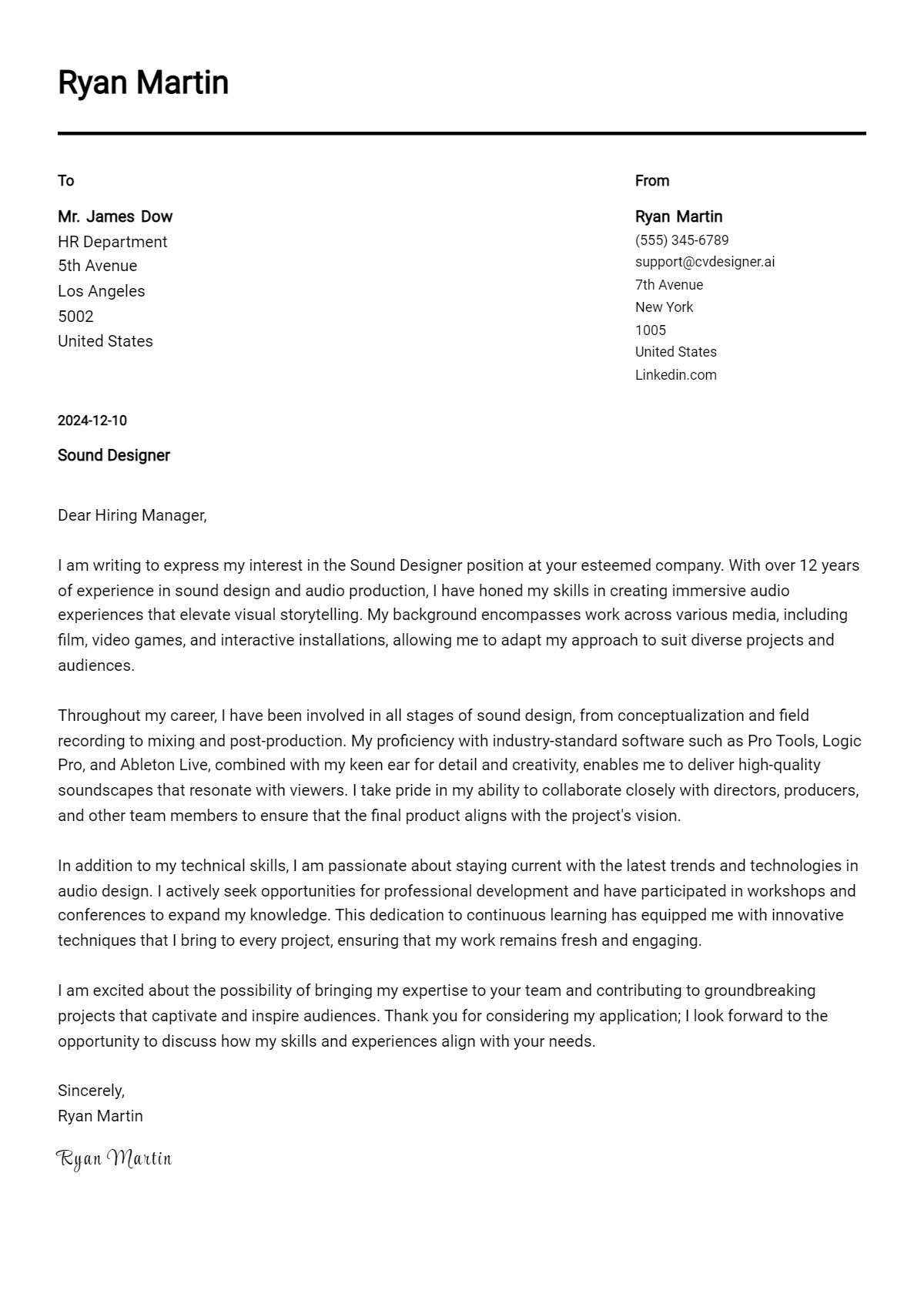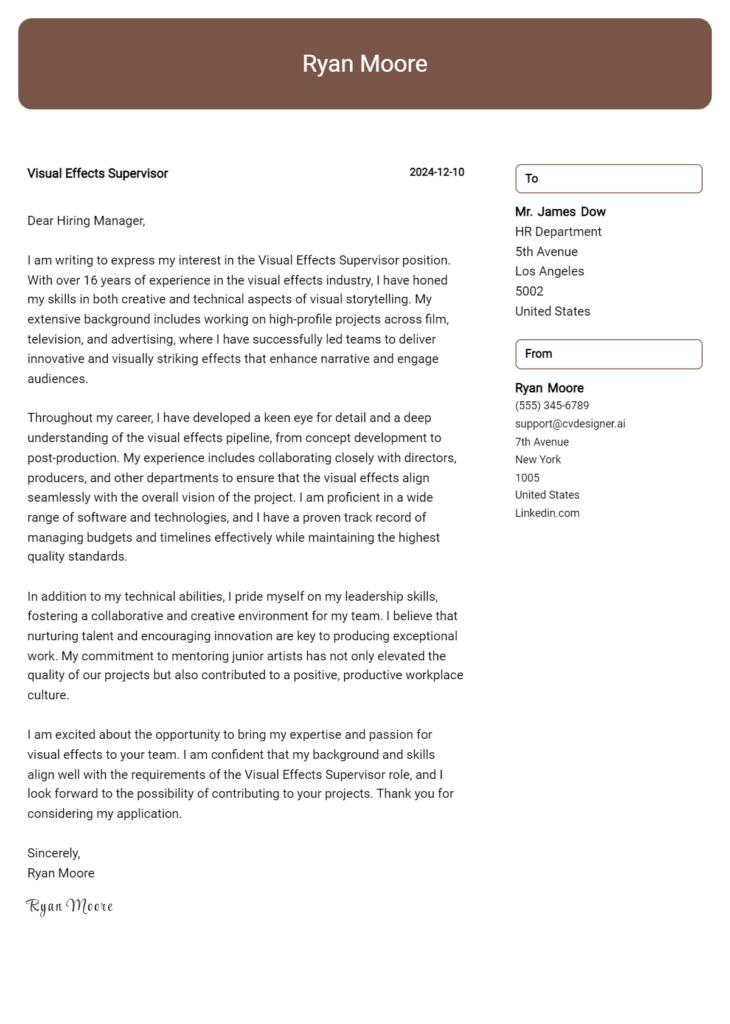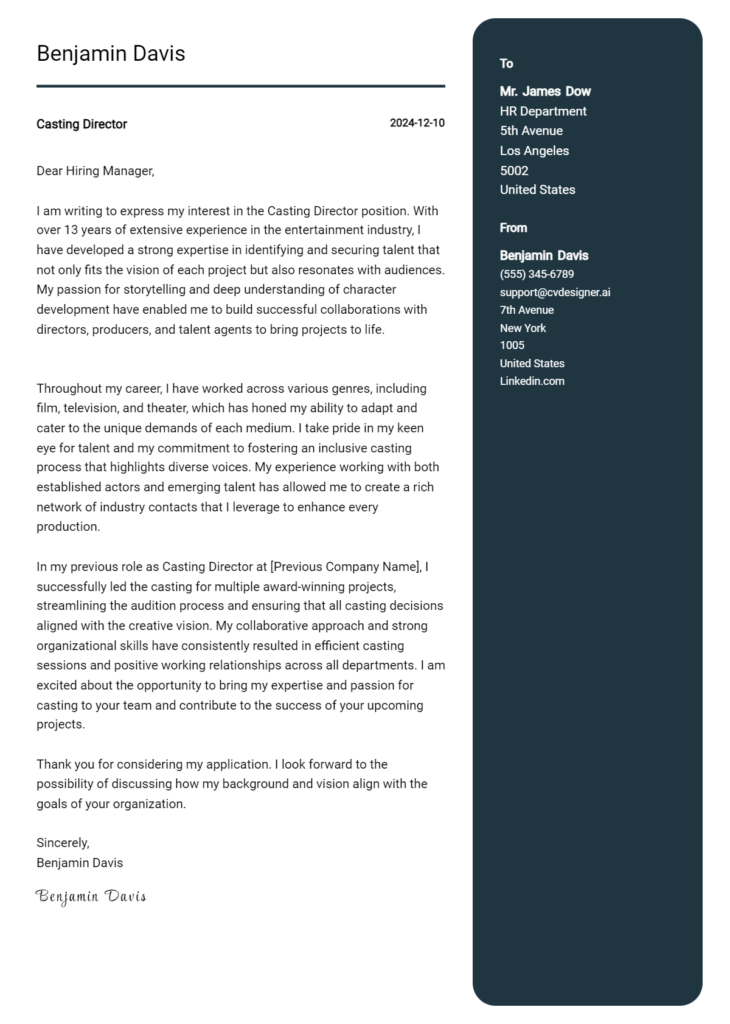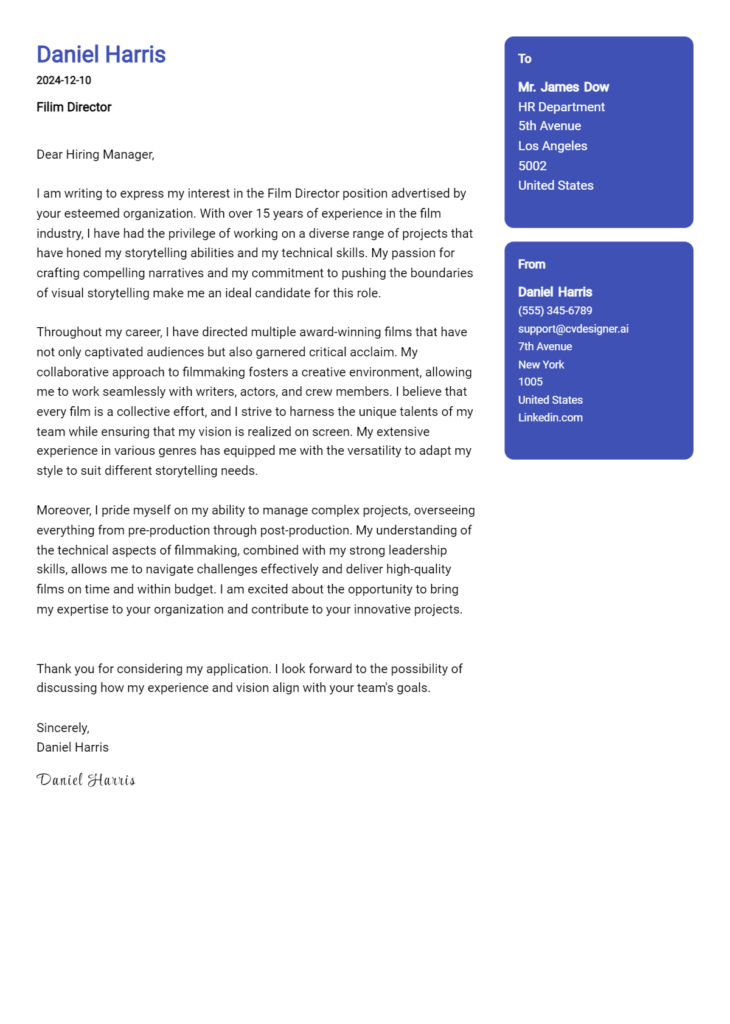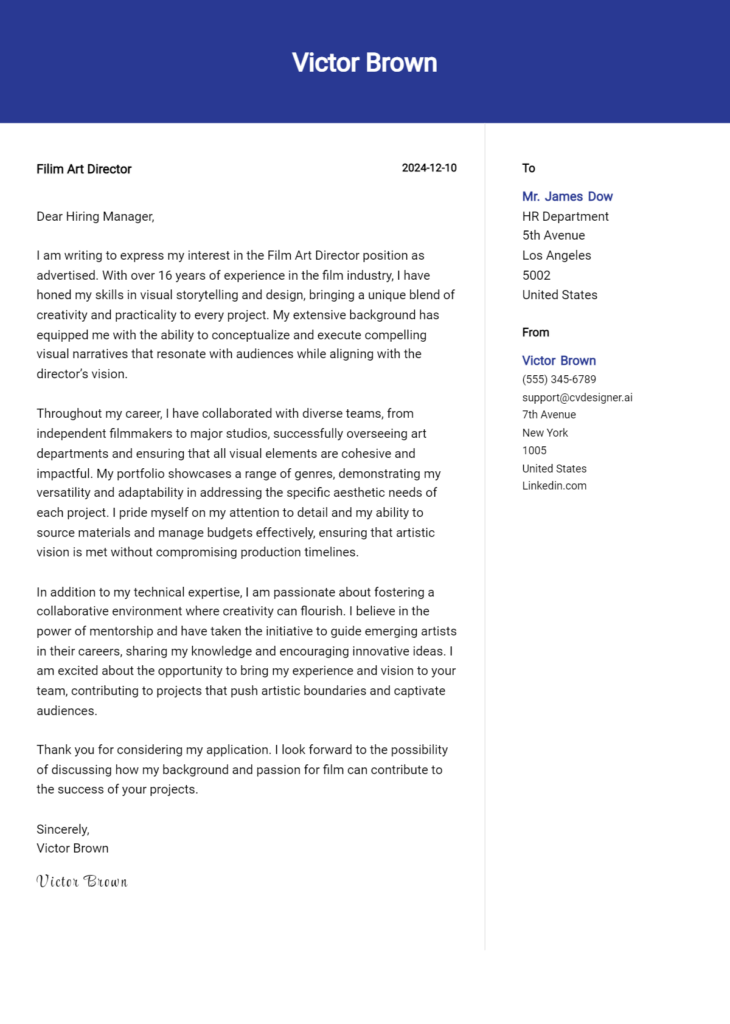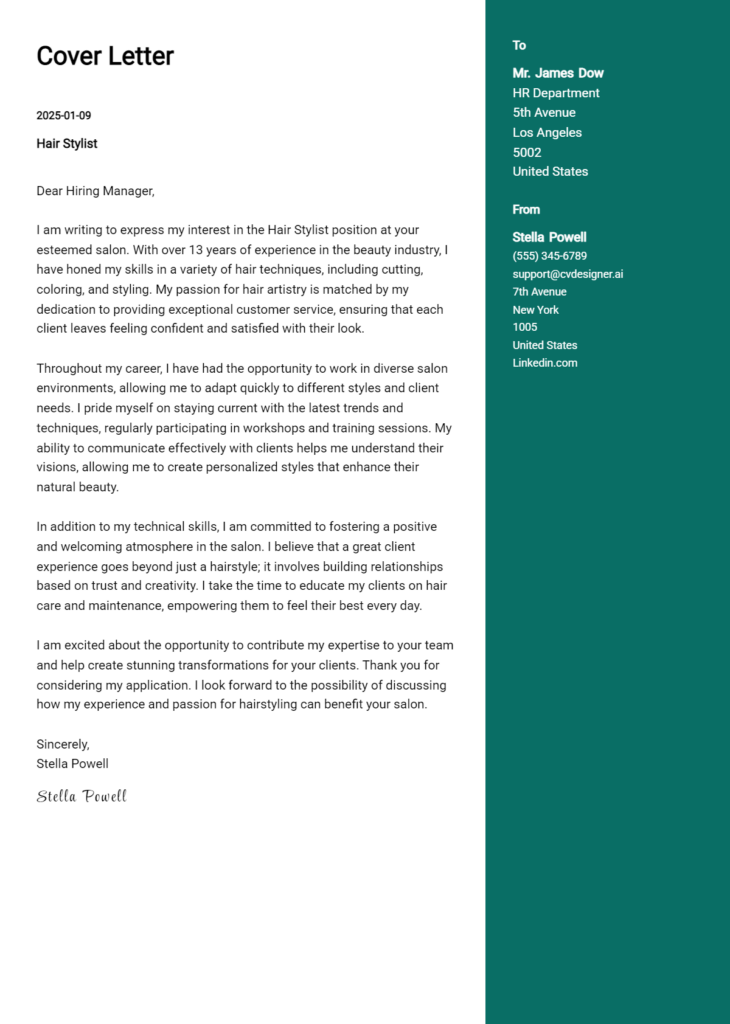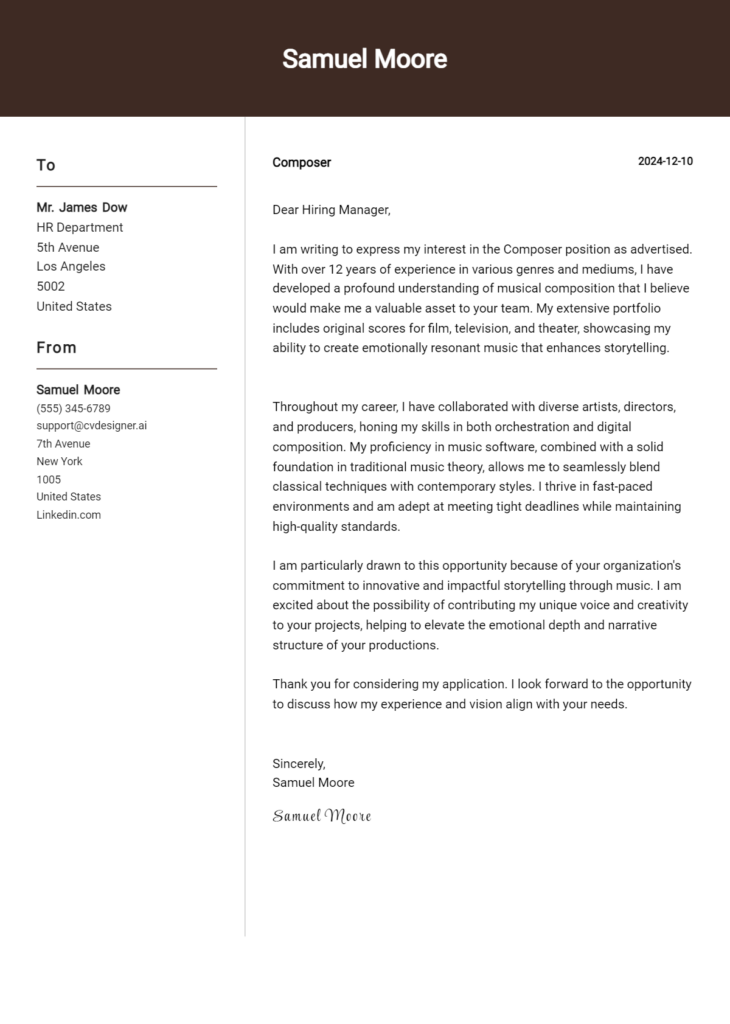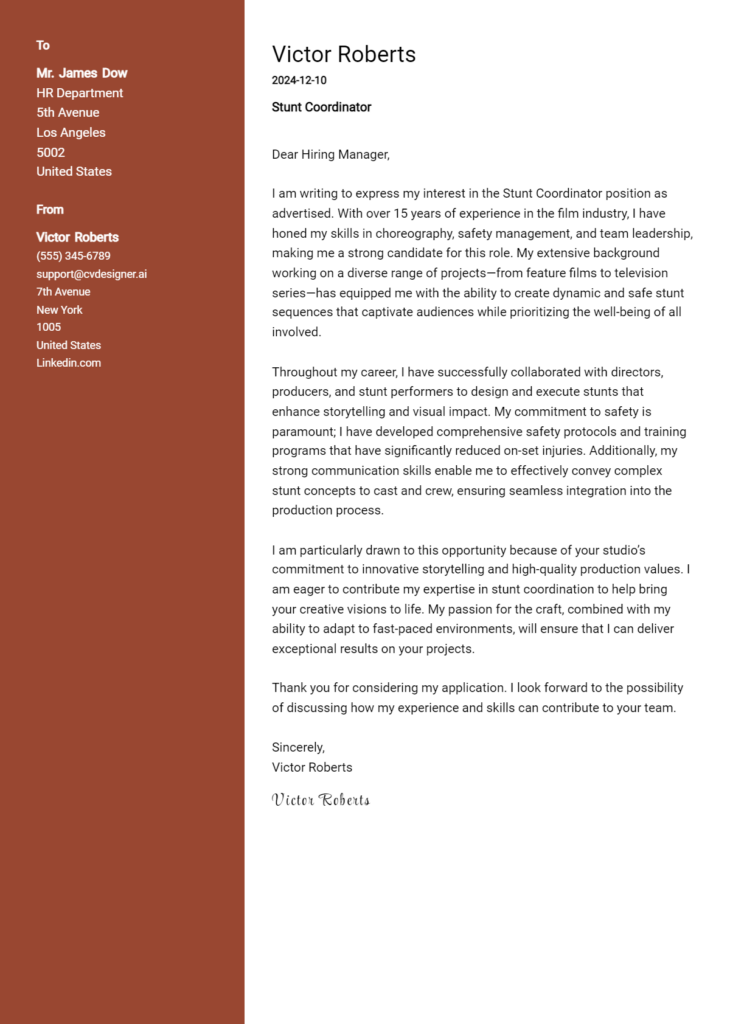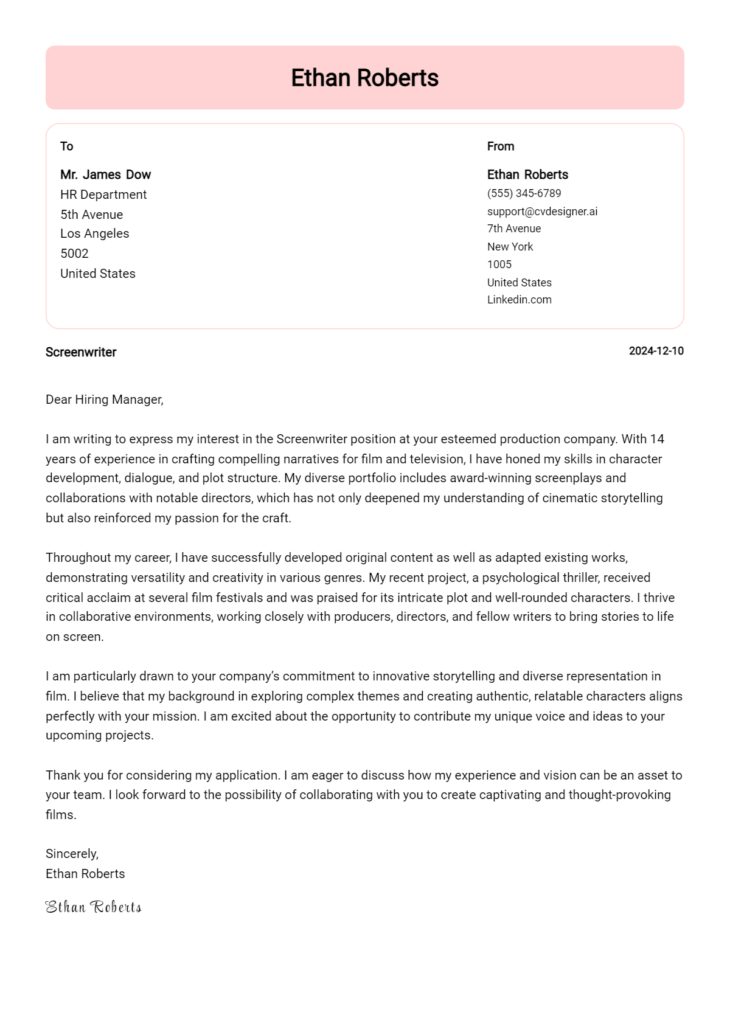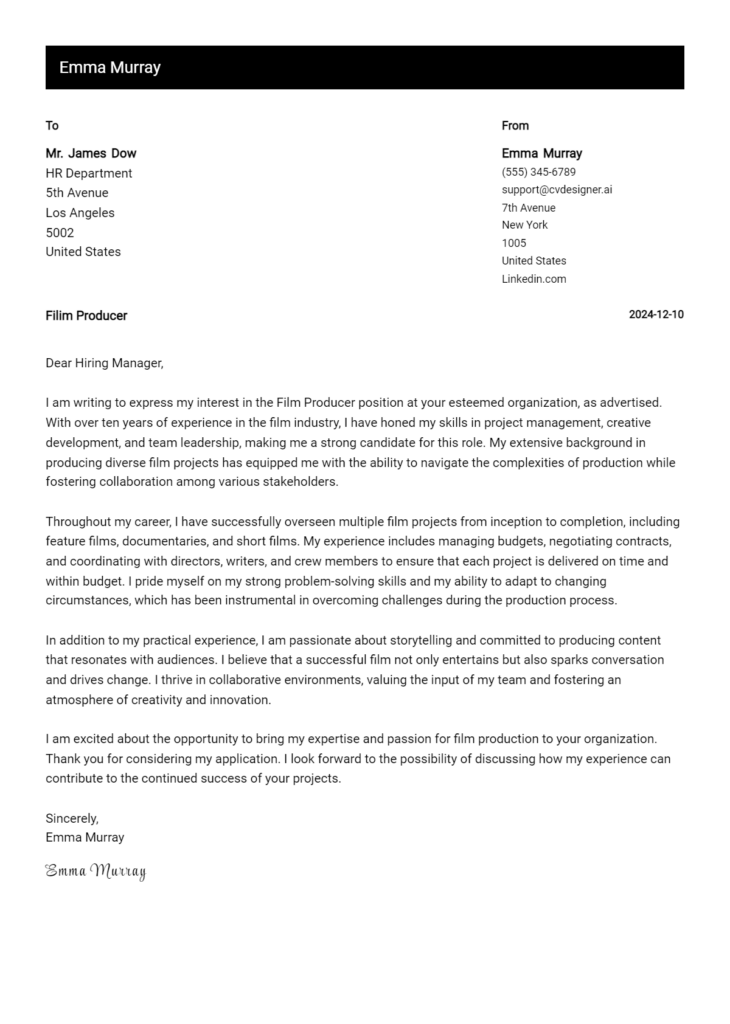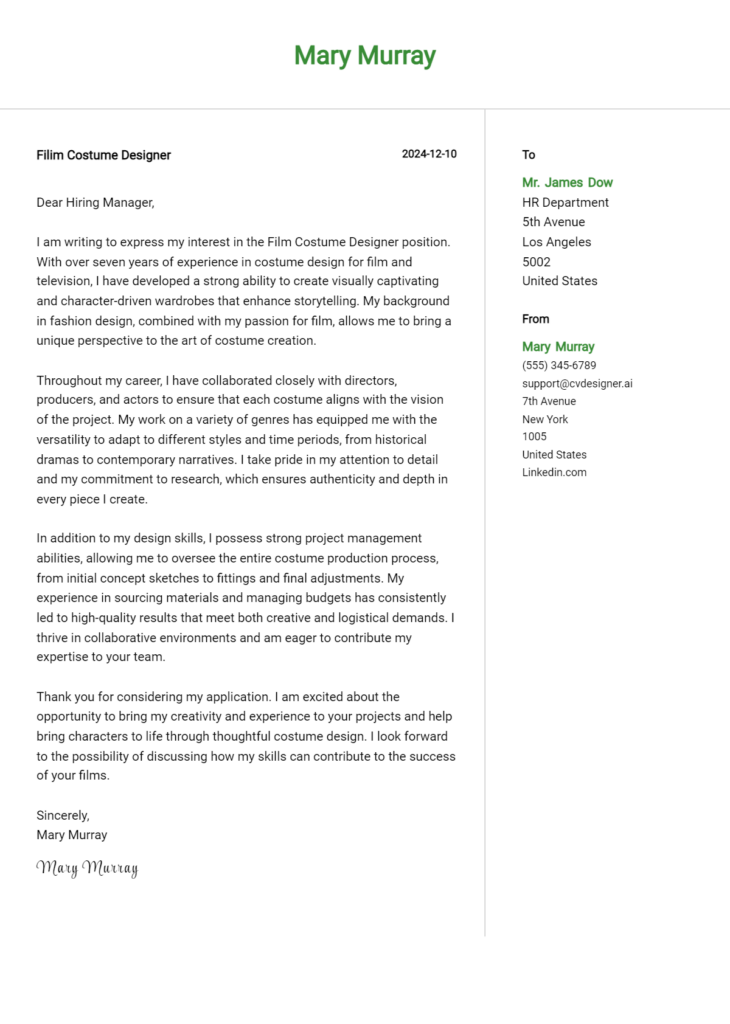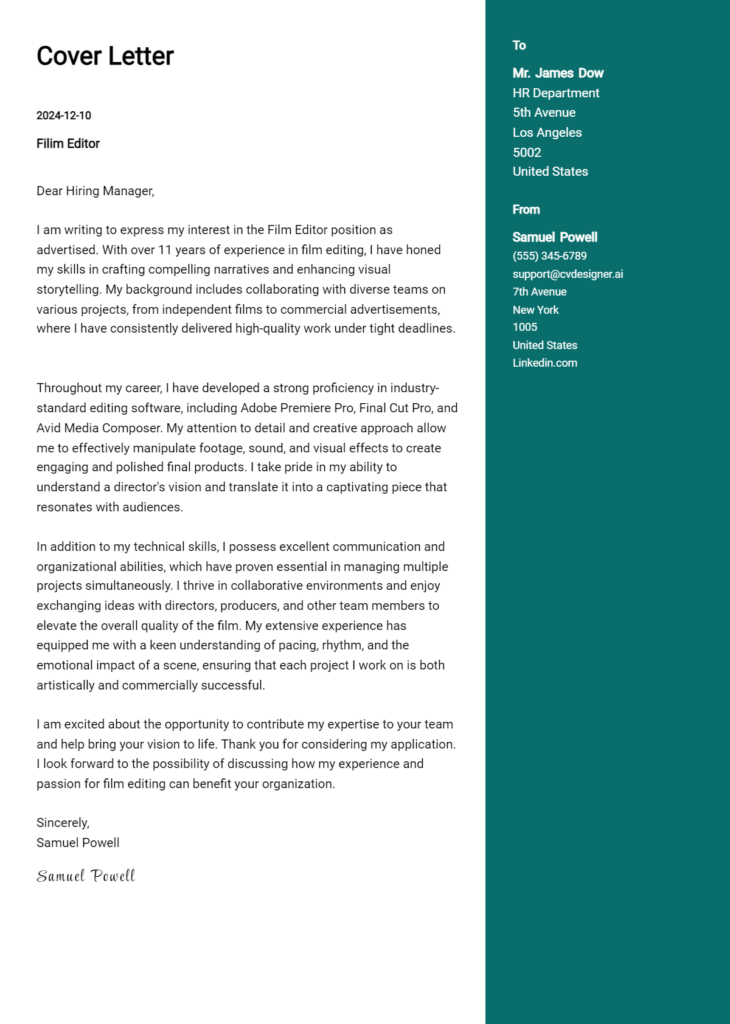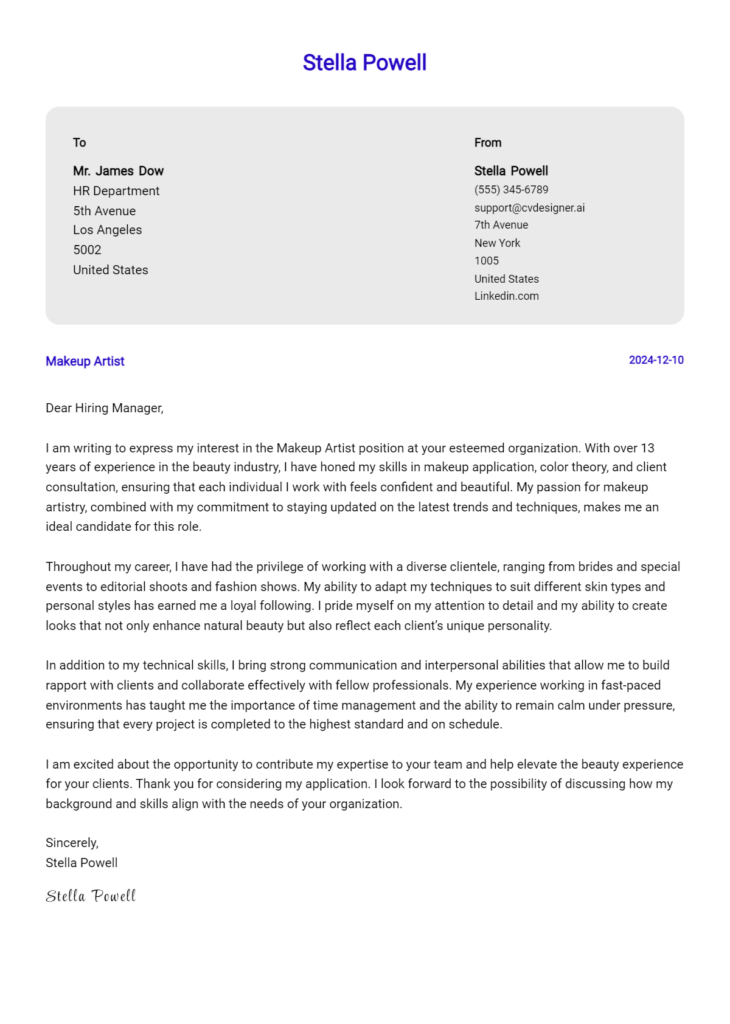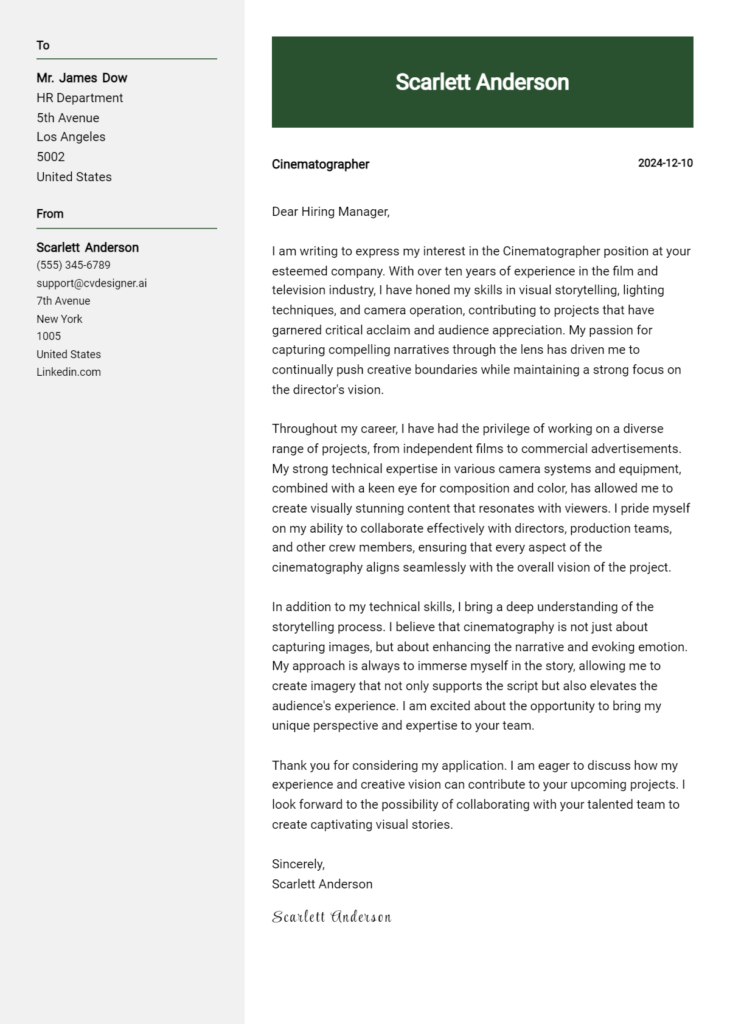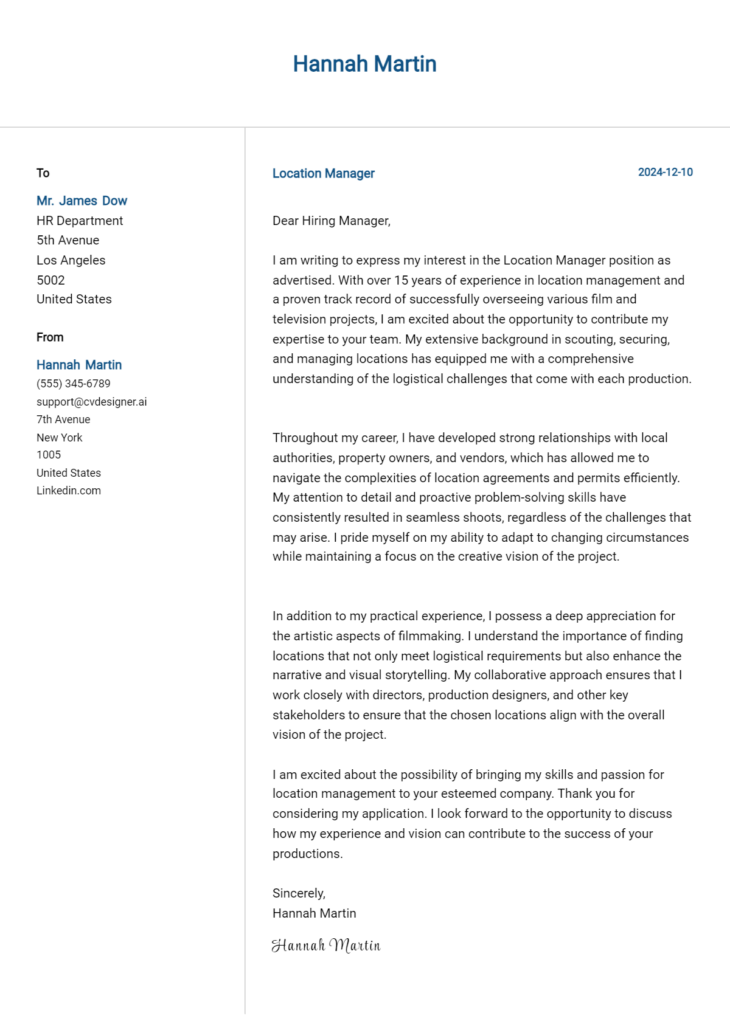Sound Designer Cover Letter Examples
Explore additional Sound Designer cover letter samples and guides and see what works for your level of experience or role.
How to Format a Sound Designer Cover Letter?
Crafting a compelling cover letter is essential for a Sound Designer, as it serves as your first opportunity to showcase your creativity and technical skills. The format of your cover letter is crucial, as it not only conveys your qualifications but also reflects your artistic vision and attention to auditory detail. A well-structured cover letter grabs the hiring manager's attention while providing insight into your unique sound design approach—attributes that are vital in the dynamic field of sound production.
In this guide, we will discuss how to effectively structure your cover letter, offering insights and sound design-specific examples to help you create a persuasive document.
We will cover the essential components of a professional cover letter, including:
- Cover Letter Header
- Cover Letter Greeting
- Cover Letter Introduction
- Cover Letter Body
- Cover Letter Closing
Each section plays a critical role in emphasizing your qualifications and professionalism. Let’s break down each part to help your sound designer cover letter resonate with potential employers.
Importance of the Cover Letter Header for a Sound Designer
The cover letter header is a crucial element for any Sound Designer, as it sets the tone for the application and provides essential information in a clear and professional manner. A well-structured header includes the applicant's contact information, the date, and the recipient's details, ensuring that the reader can easily identify the sender and the date of the application. Clarity and professionalism in the header not only reflect the applicant's attention to detail but also their understanding of industry standards. A strong header can make a positive first impression, while a weak one can lead to confusion or a negative perception.
Strong Example:
John Smith 123 Soundwave Lane Music City, ST 12345 john.smith@email.com (123) 456-7890 October 15, 2023 Jane Doe Hiring Manager Acme Sound Studios 456 Audio Drive Soundtown, ST 67890
Weak Example:
Hey, it's John! My Address Email: john@email.com 10/15/23 To Whom It May Concern
The Importance of the Cover Letter Greeting for a Sound Designer
The greeting of your cover letter is crucial as it sets the tone for the entire document. It serves as the first impression you make on the hiring manager, demonstrating your professionalism and ability to personalize your approach. By directly addressing the hiring manager by name, you not only show respect but also indicate that you have taken the time to research and understand the company culture. Avoiding generic greetings like "To Whom It May Concern" is essential, as they can come off as impersonal and unengaged. When possible, take the time to find out the recipient's name through the company website or LinkedIn. A well-crafted greeting can engage the reader and encourage them to continue reading your letter.
Strong Greeting Example
Dear Ms. Johnson,
Weak Greeting Example
To Whom It May Concern,
The Importance of a Captivating Cover Letter Introduction for a Sound Designer
A well-crafted cover letter introduction is crucial in making a lasting impression on hiring managers, especially in creative fields like sound design. This opening paragraph serves as your first opportunity to capture attention, convey genuine enthusiasm for the role, and provide a snapshot of your relevant skills and accomplishments. An engaging introduction can set the tone for the rest of your letter, enticing the reader to explore your qualifications further. Below are examples of strong and weak cover letter introductions for a Sound Designer role, illustrating the difference a compelling opening can make.
Strong Example
Dear [Hiring Manager's Name], As a passionate sound designer with over five years of experience in crafting immersive audio landscapes, I was thrilled to discover the opportunity at [Company Name]. My work on award-winning projects, such as [Project Name], has not only honed my technical skills but also deepened my understanding of how sound can elevate storytelling. I am eager to bring my unique blend of creativity and expertise to your innovative team, helping to create memorable auditory experiences that resonate with audiences.
Weak Example
Hello, I saw the job listing for a sound designer at your company and thought it looked interesting. I have done some sound design work in the past, but I am not sure if I am the best fit. I hope to learn more about what you are looking for in this role.
Cover Letter Body for a Sound Designer
The body of a cover letter for a Sound Designer serves as a critical platform to showcase the candidate's unique skills, relevant experiences, and the value they can bring to the company. This section should detail specific projects or accomplishments that highlight the candidate's expertise in sound design, such as working on films, video games, or advertising campaigns. By illustrating their proficiency with sound editing software, collaboration with directors, or innovative use of soundscapes, candidates can effectively convey how their background aligns with the company's creative vision and needs.
Strong Example
Dear [Hiring Manager's Name], I am excited to apply for the Sound Designer position at [Company Name]. With over five years of experience in the industry, I have contributed to award-winning projects, including the sound design for the critically acclaimed short film "Echoes," which received a nomination at the Sundance Film Festival. My expertise in Pro Tools and Adobe Audition allowed me to create a rich, immersive soundscape that enhanced the narrative and emotional impact of the film. Additionally, I collaborated closely with the director and composer to ensure that every sound element was perfectly aligned with the storytelling, which ultimately resulted in a powerful auditory experience. I am eager to bring my creative vision and technical skills to your team and contribute to your future projects. Sincerely, [Your Name]
Weak Example
Dear [Hiring Manager's Name], I am interested in the Sound Designer role at [Company Name]. I have some experience in sound design and have worked on a few projects. I think I would do a good job because I like working with sound. I can use some software, but I'm still learning. I hope to improve my skills and maybe work on better projects in the future. Thank you for considering my application. Best, [Your Name]
Importance of the Cover Letter Closing for a Sound Designer
The closing paragraph of a cover letter is crucial for leaving a lasting impression on potential employers. It serves as a summary of your qualifications, reiterates your enthusiasm for the position, and encourages the hiring manager to take the next steps, such as reviewing your resume or scheduling an interview. A strong closing can effectively encapsulate your unique skills as a Sound Designer and reinforce your fit for the team, while a weak closing may leave your application feeling incomplete or unconvincing.
Strong Example
Thank you for considering my application for the Sound Designer position at [Company Name]. With my extensive experience in creating immersive soundscapes and my passion for innovative audio solutions, I am excited about the opportunity to contribute to your team. I look forward to the possibility of discussing how my skills align with your needs. Please feel free to review my resume for further details, and I would be thrilled to schedule an interview at your earliest convenience.
Weak Example
I hope you like my application. I think I would be fine for the Sound Designer job. Please look at my resume. I guess we can talk later if you're interested.
Crafting an effective cover letter for a Sound Designer position is crucial in standing out in a competitive job market. A well-written cover letter not only highlights your technical skills and problem-solving abilities but also illustrates your understanding of the Software Development Life Cycle (SDLC), teamwork experience, and passion for continuous learning. Here are some tips to help you create a compelling cover letter that showcases your qualifications and enthusiasm for the role.
Tips for Writing an Effective Cover Letter as a Sound Designer
Highlight Technical Proficiency: Begin by showcasing your technical skills relevant to sound design, such as proficiency in industry-standard software like Pro Tools, Logic Pro, or Ableton Live. Mention specific projects where you utilized these tools to achieve outstanding results. Providing examples of your technical capabilities will demonstrate your readiness for the role.
Demonstrate Problem-Solving Abilities: Sound design often involves overcoming creative challenges. Share examples of how you've tackled specific issues in past projects, such as finding innovative solutions to sound quality problems or adapting to project constraints. This not only showcases your skills but also your capacity for critical thinking.
Show Knowledge of the SDLC: If applicable, mention your understanding of the Software Development Life Cycle and how it relates to sound design. Explain how you've collaborated with developers, artists, and other stakeholders to integrate sound seamlessly into various stages of production. This helps convey your well-rounded experience within the development process.
Emphasize Teamwork Experience: Sound design is usually a collaborative effort. Highlight your experience in working with diverse teams, including musicians, directors, and other sound professionals. Provide examples of projects where effective collaboration led to a successful outcome, showcasing your ability to communicate and work well with others.
Express Passion for Continuous Learning: The audio industry is continually evolving, with new technologies and techniques emerging regularly. Share your commitment to staying updated by attending workshops, online courses, or participating in industry forums. This demonstrates your willingness to grow and adapt, which is a valuable trait for any employer.
By following these tips, you can create a standout cover letter that effectively communicates your qualifications and passion for sound design. For more assistance, consider using cover letter templates or a cover letter builder to simplify the writing process.
Common Mistakes to Avoid in a Sound Designer Cover Letter
Crafting a compelling cover letter is essential for distinguishing yourself in the competitive field of sound design. Avoiding common pitfalls can significantly increase your chances of making a positive impression. Here are some frequent mistakes to watch out for:
Generic Greetings: Using "To Whom It May Concern" can make your letter feel impersonal. Research the hiring manager's name to personalize your greeting.
Lack of Specificity: Failing to mention specific projects or skills relevant to the job can weaken your application. Tailor your letter by referencing particular sound design achievements that align with the job description.
Overly Complex Language: While you want to showcase your expertise, using overly technical jargon can alienate non-technical readers. Aim for clarity and conciseness.
Neglecting Formatting: A cluttered or poorly structured cover letter can detract from your message. Follow a professional cover letter format to ensure readability.
Repetition of Your Resume: Avoid simply rehashing your resume. Instead, use the cover letter to highlight your passion for sound design and your unique contributions to past projects.
Ignoring the Company Culture: Failing to research the company can lead to a mismatch in tone and style. Show that you understand and align with the company's values and aesthetic.
Not Proofreading: Typos and grammatical errors can undermine your professionalism. Always proofread your cover letter multiple times and consider getting a second opinion.
By steering clear of these mistakes and honing in on your strengths, you can create a memorable cover letter that showcases your talent in sound design. For more insights, check out our cover letter examples.
Cover Letter FAQs for Sound Designer
What should I include in my cover letter as a Sound Designer?
In your cover letter, highlight your relevant experience, technical skills, and creative approach to sound design. Start with a brief introduction that captures the reader's attention. Then, discuss your background in sound design, mentioning specific projects or collaborations that showcase your expertise. Include technical skills such as familiarity with software like Pro Tools, Logic Pro, or Ableton Live, and any experience with field recording or Foley work. Don’t forget to express your passion for sound design and your understanding of how sound enhances storytelling. Finally, tailor your letter to the specific job by referencing the company’s projects or values, demonstrating your genuine interest in the position.
How long should my cover letter be?
Your cover letter should ideally be one page long, typically consisting of three to four paragraphs. This length allows you to provide enough detail about your experience and skills without overwhelming the reader. Aim for a concise and engaging narrative that clearly outlines your qualifications as a Sound Designer. Focus on the most relevant experiences that align with the job description, ensuring you maintain clarity and professionalism throughout. If you find yourself exceeding one page, consider trimming less relevant details or combining similar points to keep the letter succinct and impactful.
How do I demonstrate my creativity in a cover letter?
To demonstrate your creativity in your cover letter, use descriptive language that conveys your artistic vision and unique approach to sound design. Share specific examples of projects where your sound design significantly contributed to the overall experience. For instance, you might describe a project where you crafted an immersive soundscape or developed an innovative sound motif that enhanced the narrative. Additionally, you can mention any experimental techniques or unconventional tools you’ve employed in your work. Incorporating a brief anecdote about a challenge you faced and how you creatively solved it can further illustrate your problem-solving skills and artistic flair.
Should I include links to my portfolio in my cover letter?
Yes, including links to your portfolio or samples of your work is highly recommended in a cover letter for a Sound Designer position. This allows potential employers to easily access and evaluate your skills and creativity. Mention your portfolio early in the letter, providing a brief description of what they can expect to find, such as specific projects or sound design techniques showcased. Use hyperlinks for easy access, and ensure your portfolio is well-organized and highlights your best work. This not only demonstrates your initiative but also enhances your credibility by allowing employers to see your abilities firsthand.
Build your Cover Letter in minutes
Use an AI-powered cover letter builder and have your letter done in 5 minutes. Just select your template and our software will guide you through the process.

